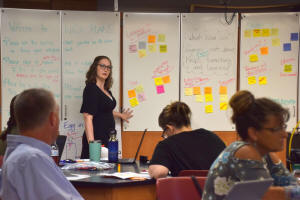|
 Next
Generation Science Standards Training for Educational Leaders Next
Generation Science Standards Training for Educational Leaders
 Send a link to a friend
Send a link to a friend
[November 14, 2019]
There is a correlation between improving
science education and keeping the United States workforce strong and
competitive. University of Illinois Extension and Bradley University
Center for STEM Education have been partnering for many years, in a
variety of ways, to help improve the learning environment for
science, technology, engineering, and math (STEM) education
throughout Central Illinois.
|
|
 This summer a new training opportunity called Next
Generation Science Standards (NGSS) was provided to area educational
leaders. NGSS incorporates the three dimensions of practices, core
ideas, and crosscutting concepts to help students build a cohesive
understanding of science over time. This summer a new training opportunity called Next
Generation Science Standards (NGSS) was provided to area educational
leaders. NGSS incorporates the three dimensions of practices, core
ideas, and crosscutting concepts to help students build a cohesive
understanding of science over time.
The workshop “PLANS – Principals Learning About Networking &
Supporting 3-Dimensional Science Learning” was designed to support
instructional leaders in figuring out constructive strategies for
mentoring teachers as they implement the Next Generation Science
Standards. Twenty-one educational leaders including principals,
instructional coaches, and department heads participated in this
first introductory workshop.

Districts, schools, and teachers across the country are working on
implementing a new vision for science classrooms based on the
Framework for K-12 Science and NGSS: classrooms in which teachers
support students in science and engineering practices for building
and using science ideas to explain real phenomena and solve real
problems.
A core challenge is the lack of curriculum materials that reflect
the dramatic changes in this vision. Traditional textbooks, lesson
plans, and units are not up to the challenge. Educators are finding
that they need to find, adapt, or create new curriculum materials to
support this 3D approach to science learning.
Participant evaluations highlighted the following:
· I have a better grasp on what the standards actually mean. I
realize that these standards are rigorous and much more than just
teaching content.
· I understand that this will most definitely take time to make the
shift from the traditional method of teaching to this new
exploratory learning.
[to top of second column] |

· My biggest takeaway is including regular "productive talk" as
an essential part of the lessons and student learning process.
· Classroom culture, modeling, and hands-on experiences really help promote
student-developed learning.
· Student-led problem-solving techniques—allowing the exploration for student
learning and the additional learning that occurs from correcting their own
mistakes.
Educational leaders committed to implement the lessons in their schools. They
planned to create work time before the school year started to encourage
discussion and the classroom culture aspect needed to facilitate the
student-developed learning environment. This shift requires that teachers use
NGSS to encourage exploration instead of drilling facts, vocab, and concepts.
For additional information on how you or your school might engage with this
exceptional programming opportunity visit mentormatchingengine.org or contact
Kathie Brown, University of Illinois Extension educator, brownlk@illinois.edu.
STEM education is a focus of many University of Illinois Extension programs in
Fulton, Mason, Peoria, and Tazewell Counties. Extension staff work with partners
and volunteers to provide hands-on learning for classroom and out-of-school
settings. To learn more about the impact these programs are making in our
citizens and communities or to get involved in upcoming programs visit the
website
https://extension.illinois.edu/fmpt
[Anita Wilkinson
Communications Program Coordinator
UNIVERSITY OF ILLINOIS EXTENSION
Fulton-Mason-Peoria-Tazewell Unit]
 |